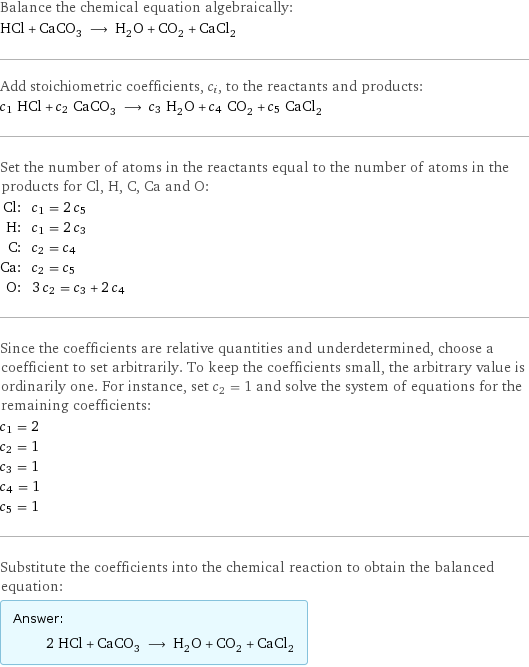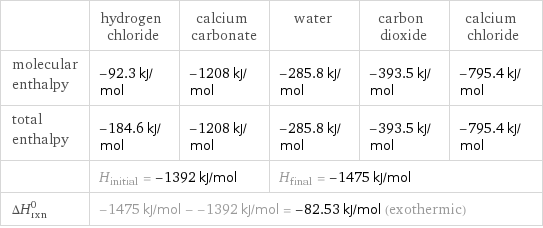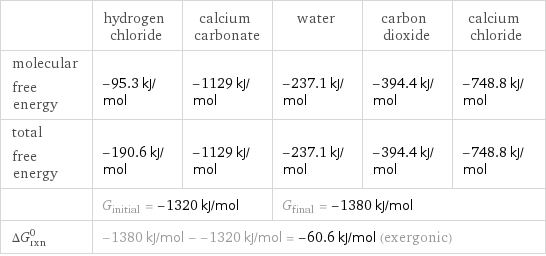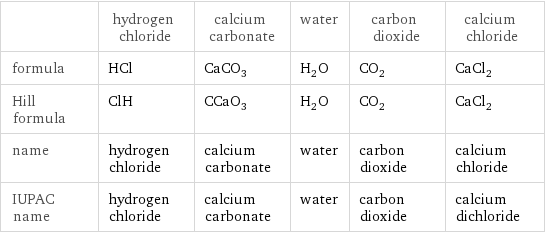Input interpretation

HCl (hydrogen chloride) + CaCO_3 (calcium carbonate) ⟶ H_2O (water) + CO_2 (carbon dioxide) + CaCl_2 (calcium chloride)
Balanced equation

Balance the chemical equation algebraically: HCl + CaCO_3 ⟶ H_2O + CO_2 + CaCl_2 Add stoichiometric coefficients, c_i, to the reactants and products: c_1 HCl + c_2 CaCO_3 ⟶ c_3 H_2O + c_4 CO_2 + c_5 CaCl_2 Set the number of atoms in the reactants equal to the number of atoms in the products for Cl, H, C, Ca and O: Cl: | c_1 = 2 c_5 H: | c_1 = 2 c_3 C: | c_2 = c_4 Ca: | c_2 = c_5 O: | 3 c_2 = c_3 + 2 c_4 Since the coefficients are relative quantities and underdetermined, choose a coefficient to set arbitrarily. To keep the coefficients small, the arbitrary value is ordinarily one. For instance, set c_2 = 1 and solve the system of equations for the remaining coefficients: c_1 = 2 c_2 = 1 c_3 = 1 c_4 = 1 c_5 = 1 Substitute the coefficients into the chemical reaction to obtain the balanced equation: Answer: | | 2 HCl + CaCO_3 ⟶ H_2O + CO_2 + CaCl_2
Structures

+ ⟶ + +
Names

hydrogen chloride + calcium carbonate ⟶ water + carbon dioxide + calcium chloride
Reaction thermodynamics
Enthalpy

| hydrogen chloride | calcium carbonate | water | carbon dioxide | calcium chloride molecular enthalpy | -92.3 kJ/mol | -1208 kJ/mol | -285.8 kJ/mol | -393.5 kJ/mol | -795.4 kJ/mol total enthalpy | -184.6 kJ/mol | -1208 kJ/mol | -285.8 kJ/mol | -393.5 kJ/mol | -795.4 kJ/mol | H_initial = -1392 kJ/mol | | H_final = -1475 kJ/mol | | ΔH_rxn^0 | -1475 kJ/mol - -1392 kJ/mol = -82.53 kJ/mol (exothermic) | | | |
Gibbs free energy

| hydrogen chloride | calcium carbonate | water | carbon dioxide | calcium chloride molecular free energy | -95.3 kJ/mol | -1129 kJ/mol | -237.1 kJ/mol | -394.4 kJ/mol | -748.8 kJ/mol total free energy | -190.6 kJ/mol | -1129 kJ/mol | -237.1 kJ/mol | -394.4 kJ/mol | -748.8 kJ/mol | G_initial = -1320 kJ/mol | | G_final = -1380 kJ/mol | | ΔG_rxn^0 | -1380 kJ/mol - -1320 kJ/mol = -60.6 kJ/mol (exergonic) | | | |
Equilibrium constant
![Construct the equilibrium constant, K, expression for: HCl + CaCO_3 ⟶ H_2O + CO_2 + CaCl_2 Plan: • Balance the chemical equation. • Determine the stoichiometric numbers. • Assemble the activity expression for each chemical species. • Use the activity expressions to build the equilibrium constant expression. Write the balanced chemical equation: 2 HCl + CaCO_3 ⟶ H_2O + CO_2 + CaCl_2 Assign stoichiometric numbers, ν_i, using the stoichiometric coefficients, c_i, from the balanced chemical equation in the following manner: ν_i = -c_i for reactants and ν_i = c_i for products: chemical species | c_i | ν_i HCl | 2 | -2 CaCO_3 | 1 | -1 H_2O | 1 | 1 CO_2 | 1 | 1 CaCl_2 | 1 | 1 Assemble the activity expressions accounting for the state of matter and ν_i: chemical species | c_i | ν_i | activity expression HCl | 2 | -2 | ([HCl])^(-2) CaCO_3 | 1 | -1 | ([CaCO3])^(-1) H_2O | 1 | 1 | [H2O] CO_2 | 1 | 1 | [CO2] CaCl_2 | 1 | 1 | [CaCl2] The equilibrium constant symbol in the concentration basis is: K_c Mulitply the activity expressions to arrive at the K_c expression: Answer: | | K_c = ([HCl])^(-2) ([CaCO3])^(-1) [H2O] [CO2] [CaCl2] = ([H2O] [CO2] [CaCl2])/(([HCl])^2 [CaCO3])](../image_source/68c90a3189b2b4eb6aed93de2df223fe.png)
Construct the equilibrium constant, K, expression for: HCl + CaCO_3 ⟶ H_2O + CO_2 + CaCl_2 Plan: • Balance the chemical equation. • Determine the stoichiometric numbers. • Assemble the activity expression for each chemical species. • Use the activity expressions to build the equilibrium constant expression. Write the balanced chemical equation: 2 HCl + CaCO_3 ⟶ H_2O + CO_2 + CaCl_2 Assign stoichiometric numbers, ν_i, using the stoichiometric coefficients, c_i, from the balanced chemical equation in the following manner: ν_i = -c_i for reactants and ν_i = c_i for products: chemical species | c_i | ν_i HCl | 2 | -2 CaCO_3 | 1 | -1 H_2O | 1 | 1 CO_2 | 1 | 1 CaCl_2 | 1 | 1 Assemble the activity expressions accounting for the state of matter and ν_i: chemical species | c_i | ν_i | activity expression HCl | 2 | -2 | ([HCl])^(-2) CaCO_3 | 1 | -1 | ([CaCO3])^(-1) H_2O | 1 | 1 | [H2O] CO_2 | 1 | 1 | [CO2] CaCl_2 | 1 | 1 | [CaCl2] The equilibrium constant symbol in the concentration basis is: K_c Mulitply the activity expressions to arrive at the K_c expression: Answer: | | K_c = ([HCl])^(-2) ([CaCO3])^(-1) [H2O] [CO2] [CaCl2] = ([H2O] [CO2] [CaCl2])/(([HCl])^2 [CaCO3])
Rate of reaction
![Construct the rate of reaction expression for: HCl + CaCO_3 ⟶ H_2O + CO_2 + CaCl_2 Plan: • Balance the chemical equation. • Determine the stoichiometric numbers. • Assemble the rate term for each chemical species. • Write the rate of reaction expression. Write the balanced chemical equation: 2 HCl + CaCO_3 ⟶ H_2O + CO_2 + CaCl_2 Assign stoichiometric numbers, ν_i, using the stoichiometric coefficients, c_i, from the balanced chemical equation in the following manner: ν_i = -c_i for reactants and ν_i = c_i for products: chemical species | c_i | ν_i HCl | 2 | -2 CaCO_3 | 1 | -1 H_2O | 1 | 1 CO_2 | 1 | 1 CaCl_2 | 1 | 1 The rate term for each chemical species, B_i, is 1/ν_i(Δ[B_i])/(Δt) where [B_i] is the amount concentration and t is time: chemical species | c_i | ν_i | rate term HCl | 2 | -2 | -1/2 (Δ[HCl])/(Δt) CaCO_3 | 1 | -1 | -(Δ[CaCO3])/(Δt) H_2O | 1 | 1 | (Δ[H2O])/(Δt) CO_2 | 1 | 1 | (Δ[CO2])/(Δt) CaCl_2 | 1 | 1 | (Δ[CaCl2])/(Δt) (for infinitesimal rate of change, replace Δ with d) Set the rate terms equal to each other to arrive at the rate expression: Answer: | | rate = -1/2 (Δ[HCl])/(Δt) = -(Δ[CaCO3])/(Δt) = (Δ[H2O])/(Δt) = (Δ[CO2])/(Δt) = (Δ[CaCl2])/(Δt) (assuming constant volume and no accumulation of intermediates or side products)](../image_source/1fecc8f892f6698cc7a6f367c16bf6ea.png)
Construct the rate of reaction expression for: HCl + CaCO_3 ⟶ H_2O + CO_2 + CaCl_2 Plan: • Balance the chemical equation. • Determine the stoichiometric numbers. • Assemble the rate term for each chemical species. • Write the rate of reaction expression. Write the balanced chemical equation: 2 HCl + CaCO_3 ⟶ H_2O + CO_2 + CaCl_2 Assign stoichiometric numbers, ν_i, using the stoichiometric coefficients, c_i, from the balanced chemical equation in the following manner: ν_i = -c_i for reactants and ν_i = c_i for products: chemical species | c_i | ν_i HCl | 2 | -2 CaCO_3 | 1 | -1 H_2O | 1 | 1 CO_2 | 1 | 1 CaCl_2 | 1 | 1 The rate term for each chemical species, B_i, is 1/ν_i(Δ[B_i])/(Δt) where [B_i] is the amount concentration and t is time: chemical species | c_i | ν_i | rate term HCl | 2 | -2 | -1/2 (Δ[HCl])/(Δt) CaCO_3 | 1 | -1 | -(Δ[CaCO3])/(Δt) H_2O | 1 | 1 | (Δ[H2O])/(Δt) CO_2 | 1 | 1 | (Δ[CO2])/(Δt) CaCl_2 | 1 | 1 | (Δ[CaCl2])/(Δt) (for infinitesimal rate of change, replace Δ with d) Set the rate terms equal to each other to arrive at the rate expression: Answer: | | rate = -1/2 (Δ[HCl])/(Δt) = -(Δ[CaCO3])/(Δt) = (Δ[H2O])/(Δt) = (Δ[CO2])/(Δt) = (Δ[CaCl2])/(Δt) (assuming constant volume and no accumulation of intermediates or side products)
Chemical names and formulas

| hydrogen chloride | calcium carbonate | water | carbon dioxide | calcium chloride formula | HCl | CaCO_3 | H_2O | CO_2 | CaCl_2 Hill formula | ClH | CCaO_3 | H_2O | CO_2 | CaCl_2 name | hydrogen chloride | calcium carbonate | water | carbon dioxide | calcium chloride IUPAC name | hydrogen chloride | calcium carbonate | water | carbon dioxide | calcium dichloride